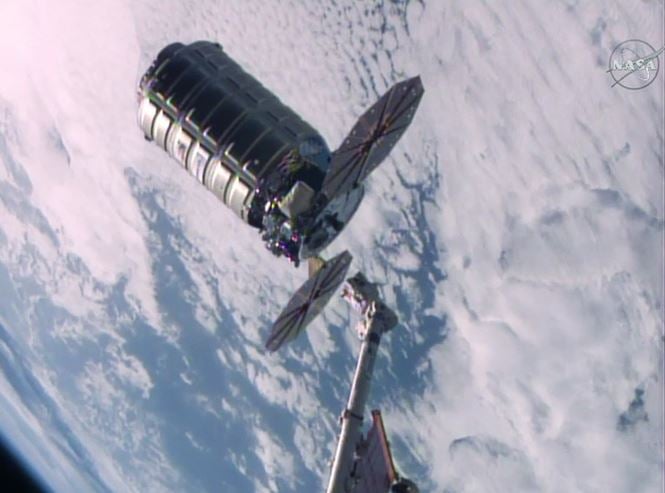NASA wants to determine how fire in space behaves, in a microgravity environment, by starting nine fires as part of a dangerous experiment which will ultimately save lives in future space missions, the US space agency explained. The nine fires will be ignited using different materials aboard an unmanned spaceship. The spaceship and its cargo will burn up upon reentry into our planet’s atmosphere.
The Cygnus cargo ship, operated by Orbital AKT, an American aerospace manufacturer and defense industry company, left the ISS (International Space Station) loaded with 1.5 tons of garbage yesterday. The whole spaceship and its cargo will burn up when it reenters Earth’s atmosphere over the Pacific Ocean on Sunday evening.
Expedition 50 robotic arm operators Thomas Pesquet of the European Space Agency (ESA) and Shane Kimbrough of NASA, commanded the International Space Station’s Canadarm2 robotic arm to release Cygnus at 8:22 a.m. EST while the ISS was orbiting 241 miles (388 km) over the Pacific Ocean.
 The space freighter ATK Cygnus moments after being released from the grips of the Canadarm2 robotic arm. (Image: blog.nasa.gov)
The space freighter ATK Cygnus moments after being released from the grips of the Canadarm2 robotic arm. (Image: blog.nasa.gov)
Fire in space testing lab
Before it reenters our atmosphere, however, the spaceship will become a giant fire-testing lab. Scientists want to improve the safety of astronauts living in a microgravity environment in space by studying how fire behaves there.
Project Manager, Gary Ruff, said:
“A spacecraft fire is one of the greatest crew safety concerns for NASA and the international space exploration community.”
The nine samples of materials that will be ignited include flame retardant fabrics that are used for making clothes for astronauts, pieces of Pexiglas used for making the space station’s windows, silicon composites, and structures used for storage containers.
Why light a #fire in space? To test how it affects materials like plastics, silicone and fabrics found in spacecraft for astronaut safety. pic.twitter.com/9cetTXycTn
— NASA Glenn Research (@NASAglenn) November 22, 2016
In this fire in space study, each sample is 5 cm wide by 28 cm long (2 by 11 inches). Each one will be placed in a separate compartment.
The researchers hope that Saffire (Saffire stands for Spacecraft Fire Experiment) will help them answer two questions:
– Will an upward-spreading flame carry on growing, or does microgravity limit its size?
– What materials and fabrics will catch fire, and how will they burn?
The first fire in this series of fire in space experiments began about five hours after Cygnus separated from the International Space Station.
Orbital ATK says that their goal is:
“To help investigators better understand flammability of these materials in a microgravity environment.
As soon as Cygnus was a safe distance away from ISS, controllers on the ground at Glenn Research Center, Cleveland, Ohio, and at Orbital ATK in Virginia, activated Saffire-II.
Cygnus will release four LEMUR CubeSats from an external deployer on November 25th. A CubeSat is a type of miniaturized satellite for space research. They will join a remote sensing satellite constellation that provides weather monitoring and global ship tracking.
Video – Fire in space experiment
In this NASA video, you can see ATK’s Cygnus cargo ship being released from the International Space Station on November 21st, bound for a destructive entry over the pacific ocean after having completed several fire in space experiments.
